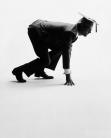Degrees of Comparison
Degrees of Comparison :
In comparing objects with each other, we may use three different forms of the same adjective.
1. Thomas is strong.
2. William is stronger than Thomas.
3. Herbert is strongest of the three.
This inflection of adjectives is called comparison and the three forms are called degrees of comparison.
The degrees of comparison indicate by their form in what degree of intensity the quality described by the adjective exists.
There are three degrees of Comparison.
1. The Positive Degree of Comparison
2. The Comparative Degree of Comparison
3. The Superlative Degree of Comparison
1. The positive degree is the simplest form of the adjective and has no special ending.
It merely describes the quality, without expressing or suggesting any comparison.
Thomas is strong.
Thus, the positive degree of the adjective strong is strong.
2. The comparative degree of an adjective is formed by adding the termination er to the positive degree.
It denotes that the quality exists in the object described in a higher degree than in some other object.
William is stronger than Thomas.
Thus, the comparative degree of the adjective strong is stronger.
3. The superlative degree is formed by adding est to the positive degree.
It denotes that the quality exists in the highest degree in the object described.
Herbert is strongest of the three.
Other examples of the comparison of adjectives are….
Positive Degree……Comparative Degree……Superlative Degree
Rich…..richer…..richest
Poor…..poorer …..poorest
Fast…..faster…..fastest
Firm….firmer…..firmest
Rules of Spelling and Degrees of Comparison
1. Adjectives ending in silent e drop this letter before the comparative ending er and the superlative ending est. Thus…..
1. wise, wiser, wisest
2. pure, purer, purest
3. handsome, handsomer, handsomest
2. Most adjectives ending in y change y to i before the endings er and est. Thus….
1. silky, silkier, silkiest
2. glossy, glossier, glossiest
3. sorry, sorrier, sorriest 3. Adjectives having a short vowel and ending in a single consonant double this before the endings er and est. Thus….
1. dim, dimmer, dimmest
2. sad, sadder, saddest
3. fit, fitter, fittest
4. big, bigger, biggest
5. red, redder, reddest
6. hot, hotter, hottest
Many adjectives are compared by prefixing the adverbs more and most to the positive degree.
Many adjectives of two syllables and most adjectives of three or more syllables are so compared.
Examples :
1. recent, more recent, most recent
2. terrible, more terrible, most terrible
3. triumphant, more triumphant, most triumphant
4. economical, more economical, most economical.
Some adjectives may be compared in either way.
Examples :
1. intense, intenser, intensest
2. intense, more intense, most intense
Note : The adverbs less and least may be used with an adjective, if one wishes to run down the scale of comparison such as….
1. terrible, less terrible, least terrible
This idiom, however, should not be regarded as comparison of the adjective.
Superlative means in the highest degree and is not applicable to least terrible which means terrible in the lowest degree.
Degrees of Comparison :
Degrees of Comparison To HOME PAGE

Related Links : Degrees of Comparison